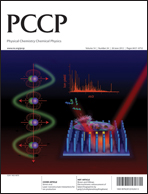Vibrational Circular Dichroismversus Optical Rotation Dispersion and Electronic Circular Dichroism for diastereomers: the stereochemistry of 3-(1′-hydroxyethyl)-1-(3′-phenylpropanoyl)-azetidin-2-one†
Abstract
The absolute configuration of a relatively large and conformationally flexible chiral compound,


 Please wait while we load your content...
Please wait while we load your content...